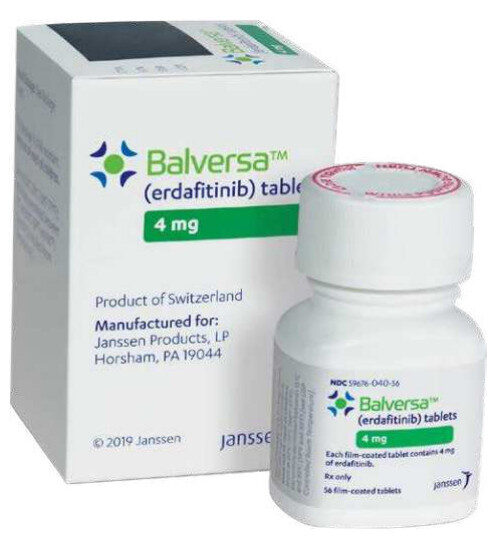Posology
The recommended starting dose of Balversa is 8mg orally once daily. This dose should be maintained, and serum phosphate level should be assessed between 14 and 21 days after initiating treatment. The dose can be increased to 9mg once daily if the serum phosphate level is <9.0 mg/dL and there is no drug-related toxicity. If the serum phosphate level is 9.0 mg/dL or higher, dose reduction is required, as per the tables in the SmPC.
Treatment should continue until disease progression or unacceptable toxicity occurs. Treatment should be initiated and supervised by a physician experienced in the use of anticancer therapies.
The tablets should be swallowed whole, with or without food, at about the same time each day. Grapefruit or Seville oranges should be avoided while taking Balversa due to strong CYP3A4 inhibition.
Precautions for use
- Balversa can cause ocular disorders, including central serous retinopathy, resulting in visual field defects. Close clinical monitoring is recommended in patients aged 65 years and older, as well as in patients who have clinically significant medical eye disorders, such as retinal disorders, including central serous retinopathy, macular/retinal degeneration, diabetic retinopathy, and previous retinal detachment;
- Dry eye symptoms are common. All patients should receive dry eye prophylaxis or treatment with ocular demulcents (for example, artificial tear substitutes, hydrating or lubricating eye gels) at least every two hours during waking hours. Severe treatment-related dry eye should be evaluated by an ophthalmologist;
- Monthly ophthalmological examinations are required during the first four months of treatment and every three months afterwards, and urgently at any time for visual symptoms;
- Patients should be monitored for hyperphosphataemia throughout treatment. Prolonged hyperphosphataemia can lead to soft tissue mineralisation, cutaneous calcinosis, non-uraemic calciphylaxis, hypocalcaemia, anaemia, secondary hyperparathyroidism, muscle cramps, seizure activity, QT interval prolongation and arrhythmias;
- Hypophosphataemia can also occur. Severe hypophosphataemia may present with confusion, seizures, focal neurologic findings, heart failure, respiratory failure, muscle weakness, rhabdomyolysis, and haemolytic anaemia;
- Complete blood counts and serum chemistries should be performed regularly during treatment with Balversa to monitor for changes;
- Caution is advised when administering Balversa with medicinal products known to prolong the QT interval or medicinal products with a potential to induce torsades de pointes, such as class IA (for example, quinidine, disopyramide) or class III (for example, amiodarone, sotalol, ibutilide) antiarrhythmic medicinal products, macrolide antibiotics, SSRIs, methadone, moxifloxacin, and antipsychotics (for example, haloperidol and thioridazine);
- Nail disorders including onycholysis, nail discolouration and paronychia can occur very commonly;
- Skin disorders including dry skin, palmar-plantar erythrodysaesthesia syndrome, alopecia and pruritus can occur very commonly with Balversa treatment. Patients should be monitored and should avoid unnecessary exposure to sunlight and excessive use of soap and bathing. Patients should be advised to use moisturisers regularly and avoid perfumed products;
- Care should be taken with sun exposure by wearing protective clothing and/or sunscreen;
- Stomatitis and dry mouth can occur very commonly. Patients should be monitored and provided supportive care such as good oral hygiene, baking soda mouthwashes three or four times per day as needed, and avoidance of spicy and/or acidic foods;
- Erdafitinib can cause foetal harm when administered to pregnant women. Pregnancy testing with a highly sensitive assay is recommended before treatment. Patients using hormonal contraceptives should be advised to use an alternative contraceptive not affected by enzyme inducers (for example, non-hormonal intrauterine device) or an additional non-hormonal contraception (for example, condom) during treatment with and until one month after the last dose;
- Breastfeeding should be discontinued during treatment and for one month following the last dose of Balversa;
- Male patients should be counselled to use effective contraception (for example, condom) and not donate or store semen during treatment with and for one month after the last dose;
- If Balversa is co-administered with a moderate CYP2C9 or strong CYP3A4 inhibitor (such as itraconazole, ketoconazole, fluconazole, clarithromycin, ritonavir), the Balversa dose needs to be reduced to the next lower dose based on tolerability;
- Co-administration of Balversa with strong CYP3A4 inducers (such as lumacaftor, rifampicin, carbamazepine, phenytoin, and St. John’s wort) should be avoided;
- If Balversa is co-administered with a moderate CYP3A4 inducer (such as modafinil, phenobarbital, primidone), the dose should be cautiously increased by 1 to 2mg and adjusted gradually every two to three weeks based on clinical monitoring for adverse reactions, not to exceed 9mg; and
- Co-administration of Balversa with P-gp substrates may increase their systemic exposure. Oral narrow therapeutic index P gp substrates (such as colchicine, digoxin, dabigatran, and apixaban) should be taken at least six hours before or after erdafitinib to minimise the potential for interactions.
Adverse reactions
The most common adverse reactions were hyperphosphataemia, diarrhoea, stomatitis, dry mouth, decreased appetite, dry skin, central serous retinopathy, anaemia, constipation, dysgeusia, palmar-plantar erythrodysaesthesia syndrome (PPES), alopecia, asthenia, alanine aminotransferase increased, onycholysis, fatigue, nausea, weight loss, aspartate aminotransferase increased, dry eye, nail discolouration and vomiting.
EU authorisation and pack size details
Balversa was first authorised in the EU in August 2024 and was added to the High Tech Scheme for May 2025. This medicine is subject to additional monitoring (black triangle). This will allow quick identification of new safety information. Healthcare professionals are asked to report any suspected adverse reactions.
This medicinal product does not require any special storage conditions.
High Tech Numbers:
Balversa 3mg film-coated tablets 84 tablets 89409
Balversa 4mg film-coated tablets 56 tablets 89410
Balversa 5mg film-coated tablets 28 tablets 89411

